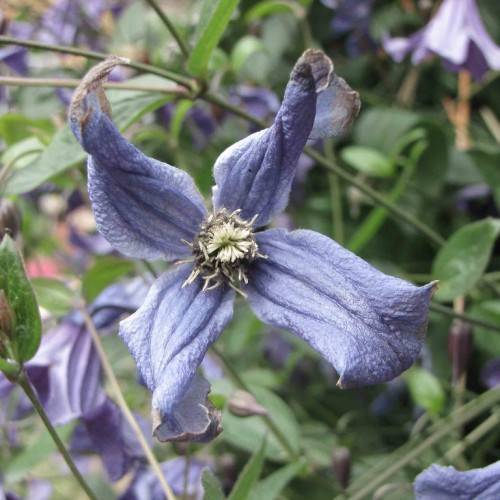
solitary clematis
Clematis integrifolia
Cycle:
Herbaceous Perennial
Watering:
Average
Hardiness Zone:
3 - 7
Flowers:
Flowers
Sun:
Full sun,part shade
Fruits:
Fruits Ready In Fall
Leaf:
Yes
Growth Rate:
Low
Maintenance:
Moderate
Salt Tolerant:
Yes
Care Level:
Medium
watering
Solitary clematis should be watered regularly to encourage healthy growth. Generally, these plants require around 1-2 inches of water every week, either directly from rainfall or by hand. During the summer months, when temperatures are usually higher, the soil should be monitored frequently to make sure it remains moist but not wet. If temperatures suddenly increase, it may be necessary to water the plants more often. The soil should never be allowed to become saturated as this can cause root rot. Additionally, it is important to avoid over-watering as this can lead to other problems, such as fungal diseases. During the winter months, watering should be reduced considerably, as the plant will be dormant. However, the soil should still be checked every few weeks and watered lightly if necessary.
sunlight
The solitary clematis (Clematis integrifolia) requires full sun to partial shade for optimal growth, flowering and overall vitality. For best results, it should be placed in a sunny spot for at least 6 hours each day, though it can tolerate up to 8 hours of direct sun during the midday. If the plant is placed in high shade, it might not bloom at all or will produce only a few blooms. By contrast, if it is exposed to heat and sun for more than 8 hours, its leaves will start to wilt and scorch. As such, the ideal amount of sunlight for this species of clematis is between 6 to 8 hours per day in mid-spring, during which the plant will be rewarded with beautiful blue flowers.
pruning
Solitary clematis should be pruned in late winter or early spring. If pruned in the late spring or summer, it won't bloom for that season. Pruning should be relatively minimal, removing only deadwood and thinning out the most crowded shoots. It also helps to remove flower stems from the previous season as these have already produced their blooms. Selectively prune 2 to 4 of the oldest stems at the base of the plant down to ground level every other year. Keep in mind that pruning too much or too aggressively can result in a loss of flowering!
